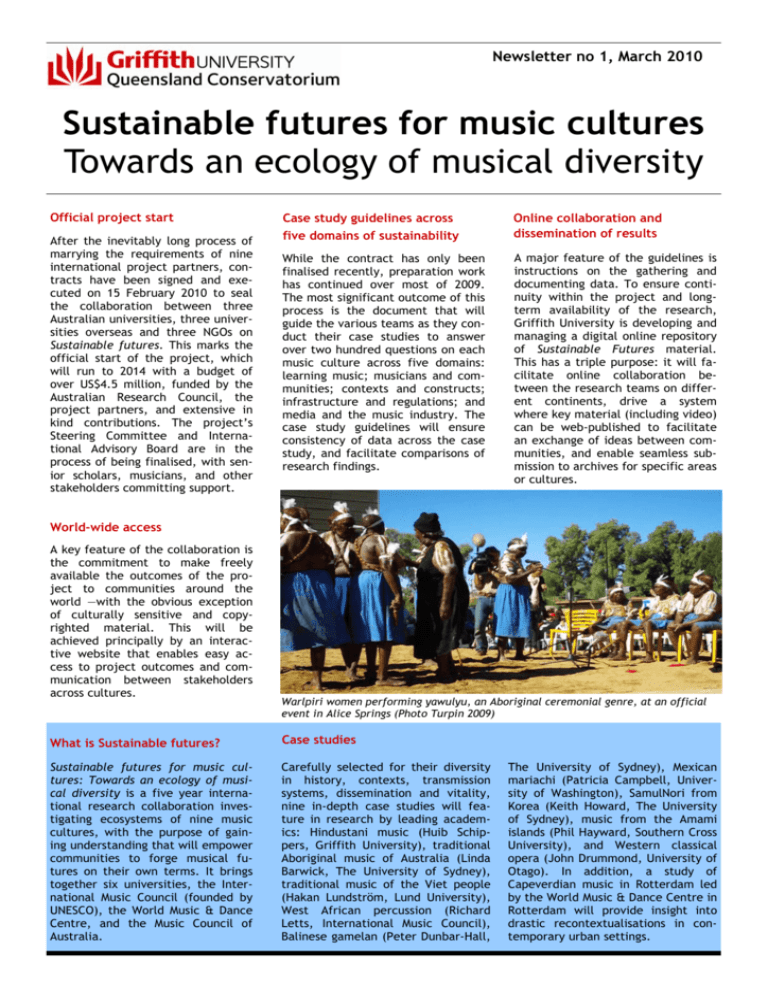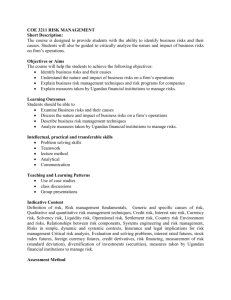Sustainable futures for music cultures Towards an ecology of
advertisement

Newsletter no 1, March 2010 Sustainable futures for music cultures Towards an ecology of musical diversity Official project start Case study guidelines across After the inevitably long process of marrying the requirements of nine international project partners, contracts have been signed and executed on 15 February 2010 to seal the collaboration between three Australian universities, three universities overseas and three NGOs on Sustainable futures. This marks the official start of the project, which will run to 2014 with a budget of over US$4.5 million, funded by the Australian Research Council, the project partners, and extensive in kind contributions. The project’s Steering Committee and International Advisory Board are in the process of being finalised, with senior scholars, musicians, and other stakeholders committing support. five domains of sustainability While the contract has only been finalised recently, preparation work has continued over most of 2009. The most significant outcome of this process is the document that will guide the various teams as they conduct their case studies to answer over two hundred questions on each music culture across five domains: learning music; musicians and communities; contexts and constructs; infrastructure and regulations; and media and the music industry. The case study guidelines will ensure consistency of data across the case study, and facilitate comparisons of research findings. Online collaboration and dissemination of results A major feature of the guidelines is instructions on the gathering and documenting data. To ensure continuity within the project and longterm availability of the research, Griffith University is developing and managing a digital online repository of Sustainable Futures material. This has a triple purpose: it will facilitate online collaboration between the research teams on different continents, drive a system where key material (including video) can be web-published to facilitate an exchange of ideas between communities, and enable seamless submission to archives for specific areas or cultures. World-wide access A key feature of the collaboration is the commitment to make freely available the outcomes of the project to communities around the world —with the obvious exception of culturally sensitive and copyrighted material. This will be achieved principally by an interactive website that enables easy access to project outcomes and communication between stakeholders across cultures. Warlpiri women performing yawulyu, an Aboriginal ceremonial genre, at an official event in Alice Springs (Photo Turpin 2009) What is Sustainable futures? Case studies Sustainable futures for music cultures: Towards an ecology of musical diversity is a five year international research collaboration investigating ecosystems of nine music cultures, with the purpose of gaining understanding that will empower communities to forge musical futures on their own terms. It brings together six universities, the International Music Council (founded by UNESCO), the World Music & Dance Centre, and the Music Council of Australia. Carefully selected for their diversity in history, contexts, transmission systems, dissemination and vitality, nine in-depth case studies will feature in research by leading academics: Hindustani music (Huib Schippers, Griffith University), traditional Aboriginal music of Australia (Linda Barwick, The University of Sydney), traditional music of the Viet people (Hakan Lundström, Lund University), West African percussion (Richard Letts, International Music Council), Balinese gamelan (Peter Dunbar-Hall, The University of Sydney), Mexican mariachi (Patricia Campbell, University of Washington), SamulNori from Korea (Keith Howard, The University of Sydney), music from the Amami islands (Phil Hayward, Southern Cross University), and Western classical opera (John Drummond, University of Otago). In addition, a study of Capeverdian music in Rotterdam led by the World Music & Dance Centre in Rotterdam will provide insight into drastic recontextualisations in contemporary urban settings. Newsletter no 1, March 2010 Initial fieldwork case study India Initial fieldwork for the NorthIndian classical music case study began with participation and a presentation in the ITC/SRA Seminar: New Trends in Indian music since Independence in January 2010. This event included extensive panel and delegate discussions on changing aesthetic norms, organisational developments (including cultural institutions and the media), audience response, and fusion music, which are all highly relevant to the Sustainable futures research. The seminar was followed by ten days of discussions amongst a research team consisting of two Indian (Suvarnalata Rao and Dhruba Ghosh) and two Dutch researchers. Schippers (Griffith University) and co-researcher Joep Bor (University of Leiden) conducted over a dozen interviews with prominent musicians, musicologists, and other stakeholders in Hindustani music. People consulted included performers and teachers across generations such as Zakir Hussain, Arvind Parikh, Purvi Parikh, Anuradha Pal, musicologist Ashok Ranade, organiser Sharad Sathe, All India Radio/ Doordarshan officers Nityanand Haldipur and Chhaya Ganguli, and corporate sponsor Ravi Mathur, CEO of ITC/SRA in Kolkata. The field trip was successful on both counts. While it became clear that the interview questions from the guidelines need to be adapted for each specific interview, the concept of an ecosystem for Indian classical music yielded inspired discussions on a number of welldocumented aspects of Hindustani music, as well as more philosophical reflections. Key topics included the central role of patronage by courts, landowners, courtesans, and later All India Radio, and adaptation of the music culture through major changes from Hindu temples to Muslim courts, and from colonisation and Independence. This resilience was largely attributed to an unbending confidence of the value of this music amongst musicians and their supporters, considerable skill in attaching the music to shifting centres of power, eclectic tendencies to reinvent Indian music history to suit the present, and great flexibility while maintaining an intangible essence. For the next stage of the case study, the research team is negotiating a close collaboration with ARCE in Delhi, which will supervise a number of Indian research assistants analysing data and policies on media, concerts and festivals, and economic impact. Other case studies It is expected that major headway on five other case studies will be made before the end of the year. Peter Dunbar-Hall travelled to Bali to prepare for interviews in June/ July 2010. He attended performances, rehearsals, and teaching sessions, tracked down research materials, and conducted a test interview. This demonstrated —like the Indian case study— that not all questions are relevant to all interviewees, and identified new ones to be included. A detailed literature review on the topic in relation to Bali is also in progress. Linda Barwick and Myf Turpin have also prepared for interviews and will travel to Central Australia in July 2010 to work on the Australian Aboriginal case study, while Keith Howard intends to research Korean Samulnori in the second half of this year. Phil Hayward will meanwhile travel to the Amami Islands, where he has already set up collaborations. For the Vietnamese case study, Hakan Lundstrom visited Hanoi in December 2009. His first project results will be presented at the ICTM Working Group meeting on Music & Minorities and Applied Ethnomusicology in Hanoi (July 2010), where Sustainable futures will feature prominently as a theme. The research team attended a number of concerts and festivals, and visited cultural institutions and music schools. Meanwhile, press clippings, brochures and publications by various organisations were collected (including a number of highly relevant topical previous ITC/SRA seminar reports), as well as a broad sample of historical recordings and more recent releases of Hindustani classical music. As the first case study in the fiveyear project, it served a dual purpose: 1) making major inroads in the data collection for one of the nine case studies, and 2) testing the planned approach of the case studies as outlined in the Sustainable Futures Case Study Guidelines in terms of content and of data management. Master musician Zakir Hussain shares his views on sustainability in Hindustani music For more information, visit the Sustainable futures website: www.musecology.griffith.edu.au





